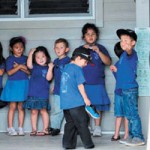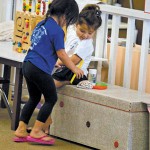Make sure the last two words to a child are positive
That’s just one of the ‘Kunimura-isms’ that spring from the lips of former Kaua’i first lady Phyllis Kunimura, whose positive educational philosophy guides teachers statewide
Lifelong educator Phyllis Kunimura believes accountability and empathy are the keys to becoming a well-adjusted human being – and she believes the lessons in how to do just that start from birth.
Author of Beyond the Sandbox-Preschool Matters, a book on how to create a bully-free, compassionate environment for children and youths, Kunimura has been director and co-founder of Kaua’i Independent Daycare Services since the 1980s. The nonprofit is a preschool for roughly 100 3- and 4-year-olds in the low- to moderate-income area of Kapa’a. She also is a former first lady of Kaua’i, when her late husband Tony Kunimura was mayor in the ’80s.
- That’s just one of the ‘Kunimura-isms’ that spring from the lips of former Kaua’i first lady Phyllis Kunimura, whose positive educational philosophy guides teachers statewide. Amanda C. Gregg photo
- That’s just one of the ‘Kunimura-isms’ that spring from the lips of former Kaua’i first lady Phyllis Kunimura, whose positive educational philosophy guides teachers statewide. Amanda C. Gregg photo
- Children play harmoniously at K.I.D.S. school, thanks to Kunimura’s philosophy: Cashus Crandell, Kaileia Apuna, Luke Held-Mayo, Colton Newmann, Kahekili Lopez and Bear Miller | Trevor Wright photo
- Children line up at K.I.D.S. school: Syra Rawlinson, Ashlynn Bloxsom, Lilliana Sunada, Mandy Gokan, Bear Miller, Cashus Crandell, Gianna Mitchell and Colton Newmann | Trevor Wright photo
- Laua‘e Gutierrez and Naomi Mokuahi | Trevor Wright photo
Staff members such as Elvrine Chow, who have worked alongside Kunimura for 15 years, say there has been an accumulation of “Kunimura-isms” over the years, which guide teachers and parents alike: “Never do for a child what they can do for themselves,” is one. And: “Make sure the last two words to a child are positive,” the latter of which, Chow says, directs children in a way that allows them to feel good about what they’re doing.
“So instead of saying ‘Don’t run,’ you say ‘Please walk,'” Chow explains.
But what really has stood out is Kunimura’s approach to resolution conflict among children, something Chow says Kunimura has been putting into practice for years.
“When I first started here in ’96, I worked in the office part time, and I sat right next to her and watched her do her conflict resolution, where she would hear each side and help them figure out what to do next,” Chow recalls. “It really helps their development. We can basically ‘stop the world’ and take those two or three children and let them each say what they experienced, and then unravel the whole thing. Having them take care of each other and to go back and practice doing it the right way sets them up for success.”
What Kunimura initially penned as a training manual for teachers evolved into 176 pages, that now include her patented approach to conflict resolution. Used as a textbook at the college level, as well as part of the registration for all new families entering K.I.D.S. school, it also has been picked up by educators for various educational programs throughout the state, including an anti-bullying campaign on Maui. Kaua’i superintendent Bill Arakaki, too, is using it as a continuum for the county, as part of a larger, anti-bullying approach to education in schools.
Creating an anti-bullying environment begins with teaching empathy and good communication.
“Empathy calms people down,” Kunimura says. “When the brain perceives empathy, the vagus nerve relaxes the body. Children must experience empathy on a regular basis to become good at expressing it. The more empathy your child sees, the more socially competent that child becomes and the happier that child will be.”
Parents need to be in on the process, too.
“To me, parents are the third leg of the stool,” she says, “the basis for how a child perceives the world.”
Creating a tolerant and bully-free society in which children can thrive relies on educating not only teachers and parents, but everyone from the janitor to the lunch lady.
“An adult often will rush over to solve a problem between two children and will jump to conclusions that aren’t necessarily correct,” she says. “There is always an instigator and reactor, and sometimes it is the younger one who is the instigator – he or she may have grabbed a toy away from the older one, for example – so it is important to help the adults see the instigator isn’t necessarily who you thought it was. The resolution/empathy process is that you have to listen to both sides.” That goes for both the adult and the child.
The book, which teaches Kunimura’s aforementioned resolution/empathy process, includes several steps: setting the scene, identifying the problem and practicing the right way to respond in an age-appropriate way.
“For 2-year-olds, you are going to want to distract them and give them something positive to do, as logic has not yet developed. It is about training what to do and what not to do. At 3, they start to understand there is a consequence to an action. By 4, they can understand how to resolve the problem: Give me back the toy, give me an apology, because that is the right thing to do, and give me a hug, because that shows empathy.”
Kunimura says it is rewarding to witness when two tykes work out an issue on their own.
“After the apology, the child asks the other, ‘Are you all right?’ Now it is time to speak up and tell your side. It is empowering. If the child says ‘no,’ then the instigator asks, ‘How can I make you better?’ Now, again, it is up to the other child to say what he or she wants. It is a learning experience for both sides that allows them to become stronger, to have ownership, and to identify how they feel and what happened.”
One child making the other feel better usually involves a hug or handshake.
“Our culture in general is losing empathy. It is so much about me, me, me, that we lose the habit of asking, ‘How does the other person feel?’ We aren’t willing to take ownership for our actions.”
Kunimura came to Kaua’i in 1961 as an exchange teacher from Ithaca, N.Y., first as a teacher at Wilcox School and then as a kindergarten teacher at Koloa School. She says over her 37 years of teaching, she has seen that kindergarten is too late to teach these techniques.
“The actual foundation of a child starts between 0 and 5,” she says, “and 85 percent of your social emotional and cognitive development happens at that point.”
When she’s not at K.I.D.S., Kunimura feeds her other passion, supporting the local community. The founder of Koloa Plantation Days annual celebration also keeps busy as a board member for Hale ‘Opio, and serving on the Keiki to Careers committee.
Also an accomplished artist, two of her paintings are in the permanent collection at the State Foundation and the Arts.
To learn more about K.I.D.S., go to kidskauai.org.








